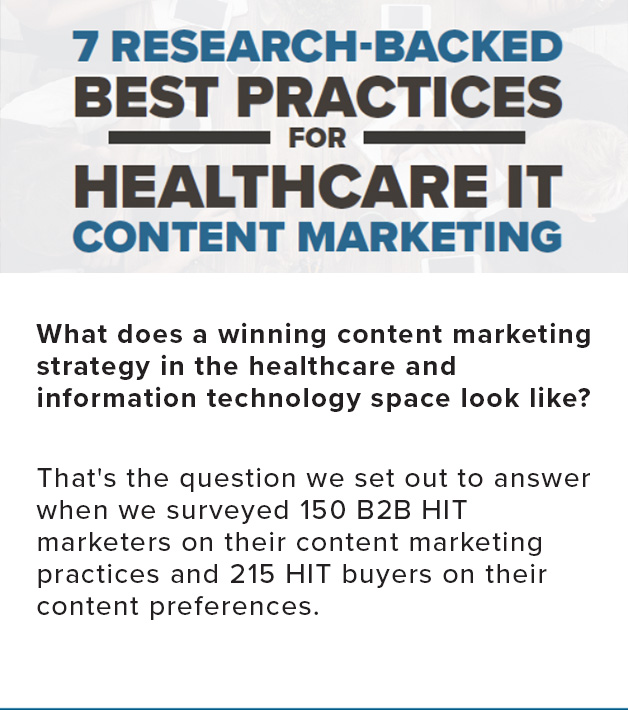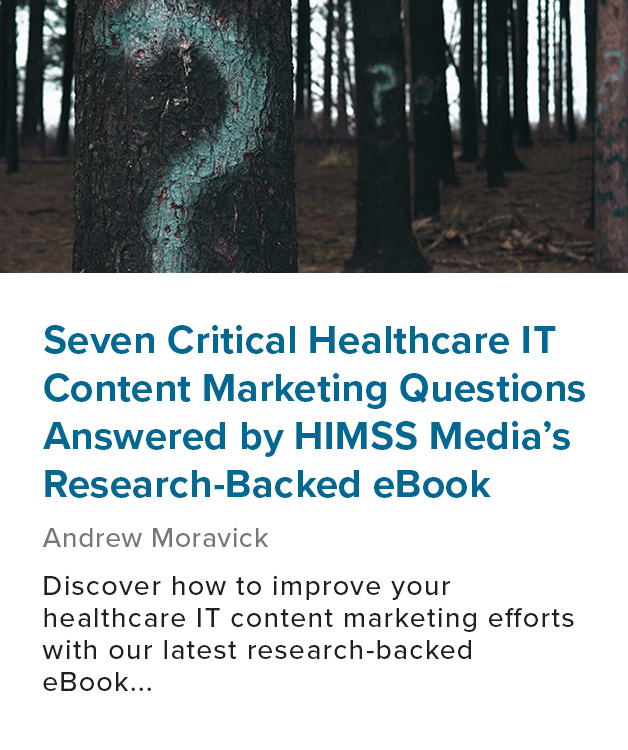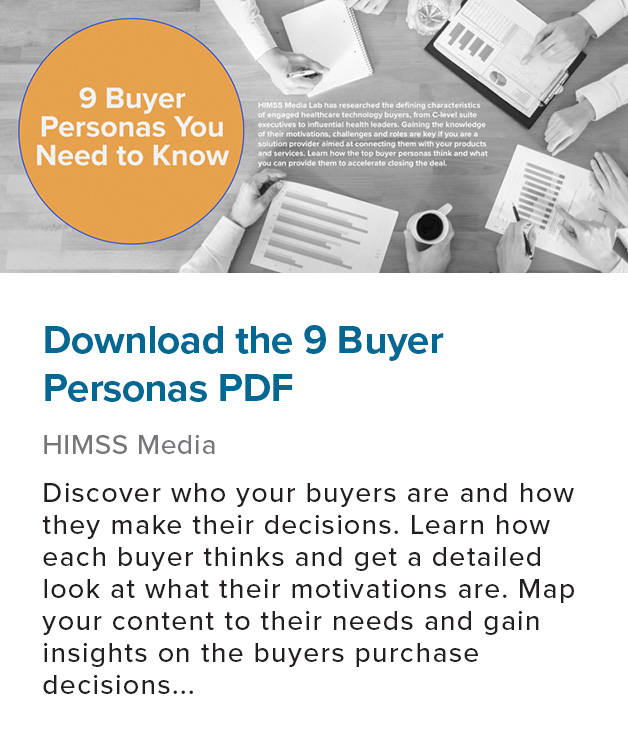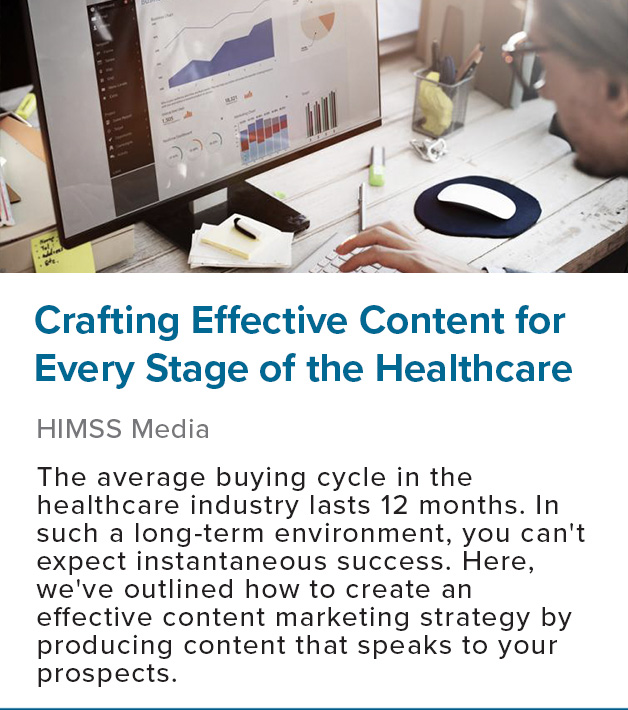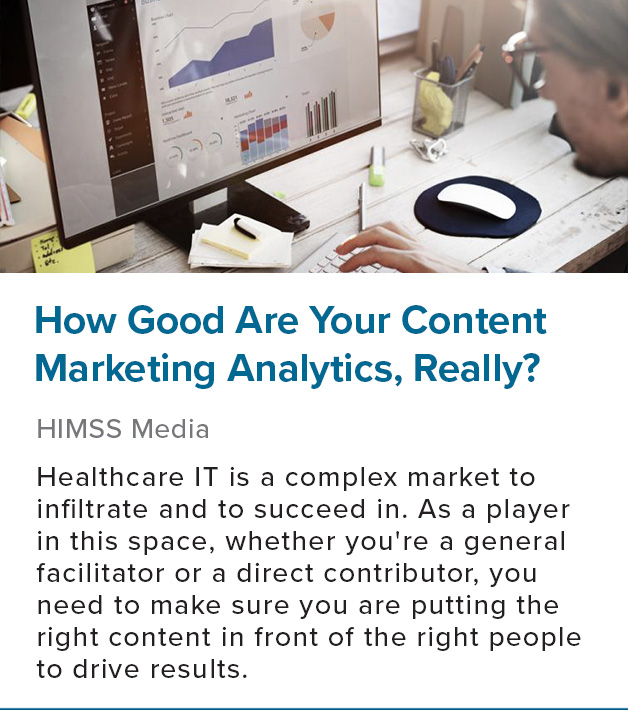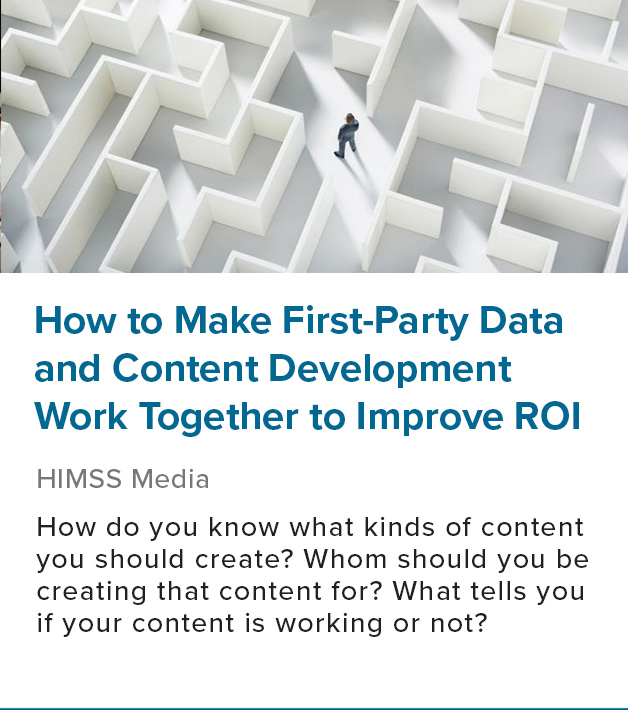
What You Need to Know About Content Marketing for Healthcare
What is Content Marketing?
Content marketing is exactly what it sounds like: it's a strategic marketing approach focused on creating and distributing valuable, relevant content to attract and retain an identified audience. That content can take a variety of forms, such as blogs, eBooks and videos; it can be distributed via platforms like email and social media, or organically, through search results.
The key here is that content marketing is a strategy. It's not just churning out content for the sake of it or repeating brand messages ad nauseum. Instead, it's a scientific approach to a creative and communicative venture. Without that strategic backbone, your content is just a bunch of stuff.
Content must add direct value for the recipient, such as providing relevant information or solving a problem; it must be substantive, relevant and consistent. Ultimately, any content created should go toward accomplishing a goal — from thought leadership to brand awareness — or eliciting an action from the audience.
Content: The Heart of Healthcare Marketing
Content marketing is a cornerstone of any good healthcare marketing strategy. Within healthcare, and in particular health information technology, content is your voice. It's your brand identity, your platform, the fuel of your marketing efforts. In short, it's essential to have content.
But having content isn't enough. For that content to make an impact, it needs to be done the right way. Healthcare IT is a challenging industry for content marketers: you need to convey value and establish yourself as an expert in a niche industry rife with experts, while balancing pressing issues like time, budget, patient needs and compliance. As a result, any content you create for healthcare IT professionals must truly mean something, whether it speaks to a problem or answers a question.
The complexity of healthcare and healthcare IT poses a few significant roadblocks to effective content marketing. To overcome them, you'll need to:
- Set and meet high standards for your content to establish your organization as a strategic partner
- Maintain significant amounts knowledge and stay on top of relevant new research across a long buying cycle — often over 12 months long
- Base your content creation and promotion on thorough market research and data analysis
- Understand the priorities of health IT buyers — as well as the tangled priorities of the buyer collective those individuals comprise
Similarly, healthcare will also change the way you write content. You can't copy-paste your process from other industries. There are three main quirks of healthcare you need to adapt to:
1. Healthcare is very compliance-driven
In healthcare and healthcare IT, compliance, privacy and patient data are crucial factors. Any content producers need to be sensitive to data quality, sourcing standards and security concerns in both topics and development process. Because patient privacy and compliance are so important, the industry at large has an understandable paranoia toward any compliance red flags or variances from industry standards.
2. Healthcare is difficult for those coming from a different vertical to understand
Healthcare is complicated. There's a reason industry professionals need so much training to succeed. For newcomers, healthcare and particularly healthcare IT can be intimidating fields to break into. It's important to not be overwhelmed by the acronyms and jargon — with time, you'll master the terminology. At the same time, you need to be sensitive to how healthcare professionals actually use that jargon. Don't fall into the trap of flashy or technical acronyms that will annoy readers rather than clarify topics.
Above all, you need to ensure that your entire team (from marketing to sales and beyond) truly understands the meaning, purpose and stories behind the content they're producing and distributing, as well as the people they're servicing. Without that deeper understanding, your content won't have the backing it needs to succeed.
3. Emotional themes are dominant in healthcare
Emotions are intertwined with healthcare themes, even beyond the intense emotions tied to patient services. For instance, ROI in healthcare and healthcare IT isn't a simple by-the-numbers discussion. Money needs to balance with life and death concerns. Organizations will consider both the qualitative and the quantitative side of ROI: you simply can't put a price on some healthcare advancements and patient successes. Different healthcare personas will have varying levels of emotional processing involved in their decision making.
Despite the amount of work needed to do it right, content is the best solution for reaching your healthcare buyers. The market is ripe for exceptional content: 90% of healthcare IT buyers report that they struggle to find high-quality, trusted sources to inform their technology decisions. With a strong content marketing strategy that accounts for industry challenges, content can become the driving force behind successful healthcare marketing.
Forming a Healthcare Content Strategy
Just like any marketing strategy, a healthcare content strategy must be based on an audience-informed, research-backed and rigorous process. Healthcare IT is a challenging industry, and content is a challenging field to get right. Only the best and most strategic content campaigns will rise to the top.
So what does it mean to have a robust strategy? Well, it's the opposite of an empty healthcare content marketing strategy. An empty strategy is poorly defined and full of content that offers more noise than value. A weak strategy is based on assumptions rather than data and fails to improve upon past experiences.
By contrast, a strong strategy is based on content that truly offers readers something valuable and therefore sparks conversations among the complex healthcare buyer collective. That content is built to drive forward desired outcomes and position your organization as a relevant, trusted source of information.
In other words, a good healthcare content marketing strategy is well-planned, thoroughly researched and based on high-quality content that drives results. That takes planning, extensive data analysis and a deep understanding of your target industry and buyers. It's a lot of pieces to juggle, but with careful preparation and an awareness of best practices, you can formulate a powerful content strategy geared toward the healthcare IT industry.
Planning and Prep Work
Assess Your Resources
Before you begin, take a hard look at whether or not you have the capacity to run a full healthcare content marketing strategy — because it's the kind of undertaking that's not worth doing unless you're doing it well.
Here are just a few of the things you need:
- Resources to research and create valuable, in-depth content consistently, whether that's dedicated in-house authors, expert contributors or even freelance writers in a pinch
- Someone to manage those writers and ensure their work reflects your brand — people who understand marketing content
- Trusted subject matter experts to contribute to or review your content to assess accuracy and quality — people who understand the context of healthcare
- The capacity to run constant content revisions to optimize every piece of content
- A hefty amount of existing content to fuel your healthcare content marketing engine
- Data analytics teams to assess the impact of your content
If you don't have an experienced team or you simply don't have enough content, you may want to consider outsourcing your healthcare content marketing.
Perform a Content Audit
If you have your resources in place, it's time to assess what you're doing well and what needs to change when it comes to content strategy. The best way to do that is with a thorough content audit.
A content audit involves more than gathering existing assets. It also means more in-depth steps such as evaluating your current content creation processes, assessing the quality of existing content and determining whether your content is optimized for the buyer personas you want to target.
Check out this blog post to learn more.
Identify Key Metrics
Remember, your content should live within a strong strategic framework. Define that framework by establishing some key benchmarks, especially around customer engagement. To refine your strategy, you need to know what it means for your content to do well — or for it to flop. This should dig deeper than surface metrics like views; continue assessing which metrics really track with your content's impact and your campaign goals, and use those as benchmarks.
Learn more in this blog post.
Developing Your Content Strategy
At its core, a good content marketing strategy is well-rounded with a good mix of high-quality content that's tied to key deliverables.
Of course, having a consistent core principle is one thing, but executing that strategy across a variety of situations is a different ball game. Content strategies can vary wildly based on context and your organization's goals. So rather than offer a prescriptive "best strategy," we've compiled a thorough list of dos and don'ts for strategic healthcare content marketing.
Consider these guidelines as the architecture to developing a content playlist. The better your playlist, the more it'll resonate with your intended audience; these tips will help you craft an effective, impactful playlist.
This is just the tip of the iceberg — check out this post for more tactics and strategy tips.
The Dos
1. Craft a well-rounded strategy with a variety of content.
Your content playlist shouldn't repeat the same song over and over, nor should it only draw from one genre of music — that's how you exhaust your audience. To keep people engaged, serve up content that rounds out a diverse yet cohesive lineup.
After all, no one asset will ever accomplish all of your objectives at once. Content should alternatively entertain, address problems, inspire, provoke discussion and so on. Your audience is made up of individuals; give them options.
Well-rounded also means you take into consideration all the different roles your content needs to fill. For instance, you'll need content that speaks to every stage of the healthcare buyer's journey. Remember that your content should serve a purpose and drive toward an objective, including moving prospects down the funnel.
2. Factor in other campaigns or upcoming content needs like live events.
Your content strategy should take a bird's eye view of all relevant factors. That might include an upcoming event or other in-flight campaigns that will impact your content production, such as new product releases.
3. Establish a consistent brand that ties together your content.
In healthcare, reputation and trust are key. Your content can't build up your reputation if it doesn't send a consistent brand message.
4. Keep your audience central.
The audience is an essential piece of any content marketing because it will inform your content creation. That's especially true in healthcare and healthcare IT because audience standards are so high. The HIT audience is a complex tapestry of healthcare buyer personas, many of who influence each other without regularly interacting face to face.
Your content needs to encourage those personas to interact, so aim to produce content people want to talk about. Create content that speaks to the needs of both individual personas and the larger buyer collective. One key tip here: involve healthcare professionals and industry experts when you're creating content to align your content with your audience.
5. Quality, quality, quality.
To market in healthcare, you need to dial up the quality of your content. There's no point in just throwing something out there to see what sticks. You need to convince your audience that you offer valuable information, deliver reliable insights and are as unbiased as possible. That means zero gimmicks, no attention-seeking clickbait, no pushy or salesy language and no content that's merely adequate. Instead, write for value, implement a rigorous process that includes strenuous peer reviews and let your content speak for itself.
6. Base your strategy on data.
In the high-stakes world of healthcare content, data should inform your every move. In marketing, you will have to go out on a limb every now and again, but when you do, make sure the hunch you're operating off of is still testable — hunches and hopes simply won't cut it on their own. Robust data collection enables you to take those chances and prove their results. To make every piece of content count, analyze its impact — and then learn from those insights.
The Don'ts
1. Fall into the "random acts of content" trap.
It's worth reiterating: an empty content strategy just won't fly in the healthcare industry. Your content should be premeditated and mapped to a purposeful bigger picture. Randomly producing content based on ad hoc needs or the desire to write about a certain subject is an easy trap to fall into. Combat this hazard by putting in the hard work of creating that bigger picture and using it to guide your content.
2. Put the container first.
Another tempting trap: designing content to fit a particular format. Healthcare buyers care far more about the content itself than the container it's in — they'll look at it on a cocktail napkin if it's great stuff.
Certainly, a variety of formats is beneficial, and modern forms of marketing like video come with some big advantages. But you should never let a shiny format detract from or obstruct the meat and true value of your content. Instead, identify that value and find a format that lets it shine.
3. Rely on surface-level or incomplete data.
We've harped on the fact that data is essential, but the truth is, having the right data is the real lesson here. Don't be distracted by surface-level data with surface-level interpretations, like "this asset got 200% more downloads so we'll build all our future assets on this model." You'll find it hard to extract real meaning from that data, and it's easy to be mislead by outliers.
Instead, dig deeper. Set up data markers that can help you glean insights like "this person opened this asset, which focused on monetary ROI and this strong emotional theme." Every piece of data should involve multiple factors that reveal truly useful insights about that person, including why they engage with certain types of content. Otherwise, relying on shallow data is like clapping with one hand: you simply don't have enough there to make it work.
The Importance of Data Analysis
One more time for completeness: data is essential. If you produce content but don't tie in data analysis, it isn't a content strategy. It's simply content production.
Data tracking is, to use a healthcare metaphor, the central nervous system of a content marketing strategy. Treat content strategy like the scientific method, with proposed theories, tests, observations and analysis. Measure every aspect of your content's performance and use that data to continually optimize your strategy. That includes what you write, how you write it, who you target and how you appeal to those people. Basically, any element of your content efforts that you can track to produce actionable, data-driven insights, you should track. Data should be the "why" behind your strategy.
Incorporate Data Effectively
To see all these strategic benefits, you need to use data well. Surface-level data won't get you very far, and neither will flashy metrics that don't actually track against the success of your content. Find metrics that work for you and genuinely correlate with your benchmarks of success. Just as important: stick with those metrics — don't be tempted by cool ideas or results that seem easy to report.
It's important to note that using data well means tracking failure as well as success. Data can tell you what to avoid as much as what to aim for. Those insights can help you find value in a seemingly failed experiment, even if they're less exciting to report.
Above all, data should help you understand your buyers, such as who's actually engaging with your content. Is it your target audience, or groups you don't expect? If they're unexpected "unusual suspects," why are they interested, and should they be part of your target group? Similarly, data analysis can help you learn how to personalize content for your buyers, such as the unique quirks of niche groups, preferred platforms, effective formats or emotional triggers that really move a certain persona.
That level of sophisticated analysis may sound out of reach, but it's very achievable with the right approach. Don't underestimate just how much data you can glean from your content — you simply need to bake comprehensive data indices into your content. Tag every piece of content you create with all relevant factors: topic, funnel stage, target personas, emotional triggers, format and so on. You can then link those factors to anyone who consumes that content, and start digging into that next level of what drives your buyers.
Producing Healthcare Content
So, you've established your strategy. The ugly underbelly of all this highbrow strategy is the content creation process itself. This is where the rubber hits the road.
In the simplest terms, your production process should look like this: develop high-impact, compelling content regardless of format; optimize based on all available data; distribute that content; analyze; iterate. Developing compelling content starts with the right topics and the right resources.
As always, there's more to be said here. Check out this post for more discussion on how to produce powerful content in-house or this post for a deep dive into how to evaluate and improve your content.
Choose Impactful Topics
To choose topics, you need to dig into two crucial buckets:
- What makes your product or service special in the eyes of customers, rather than just another commodity?
- What problems does your audience face that you can help solve?
These ideas should be a significant guiding factor in any topic you choose. They feed off of each other, but at their core they relate to a key question: why should your audience care?
Audiences want to have answers or interesting topics delivered to them, but they're only willing to give up their time if they have some stake in that content. This is especially true in the fast-paced world of healthcare, where everyone from CIOs to doctors is short on time.
If you don't have a clear understanding of your product's unique value or your audience's pressing problems, take a step back and research intensely to find out. With this knowledge, you can chose topics that are most likely to speak to your buyers or make an impact.
You can then move on to other guiding factors, like which emotional triggers make the most impact or whether you want the piece of content to stand as thought leadership.
Find the Right Experts
Healthcare and HIT are complex industries. To navigate these topics, you need experts to guide you, from healthcare providers to tech gurus. Moreover, having an experienced resource tied to your content will give that asset a huge boost in both credibility and reach.
As always in healthcare, that principle comes with numerous wrinkles and complications. Any expert you find — and for niche subjects within HIT, these are few and far between — must be legally able to speak on that topic, or able to navigate around common legal obstacles. Even then, most healthcare professionals can't show favoritism to any particular vendor, so you may struggle to source someone willing to talk to you or discuss your product. Consider looking outside your target group to peer resources or even those outside the industry for fresh perspectives.
You'll also have to contend with a wide range of subject matter experts that might run the gamut from someone highly commercial who's the face of an operation to a director of technology who rarely contributes to content pieces. You'll need to learn how to balance those resources and translate those wildly different experts into effective content.
For more details, read this post on what to look for in an HIT subject matter expert, or this one on how to source those experts.
Optimize Your Content Distribution
Healthcare doesn't just change how you create content. It also changes how you distribute it.
At the end of the day, content distribution simply refers to how people get information. Distribution can be planned or directional, which means that it's sent out in a targeted way for people to consume. However, it can also be organic.
In healthcare, organic, peer-to-peer distribution is the norm. Healthcare, and particularly HIT, are surprisingly small industries with a high level of camaraderie — at the end of the day, everyone's on the side of saving lives. As a result, there's a tremendous amount of structured and conversational distribution happening among healthcare professionals.
Of course, organic distribution presents a challenge for marketers: it's almost impossible to control. Here are a few tips to turn it to your advantage:
1. Use your content to spark conversations.
As mentioned above, the best content will inspire genuine discussion by speaking to pain points, solving a problem or appealing to emotion. If peer-to-peer conversations are an important mode of distribution (and our research and customer conversations show that they are), then your content should aim to be a conversation piece.
Your insights should be thought-provoking with rich, meaty subjects. Gimmicks or empty clickbait are an absolute no-go: in an industry of such high stakes, content needs to be worth the time to read and interesting enough to share.
2. Take advantage of trusted sources, platforms and events.
Your content will go further if you give it a good launchpad. Events, for instance — especially conferences — are a huge driver of informal sharing of information. Align your content with a key speech or promote it at the event to spark that conversation.
Similarly, look for trusted platforms, whether it's a renowned medical journal or a known industry name like HIMSS. Being a trusted source carries incredible weight, and it's a great way for your content to get its foot in the door.
3. Improve your distribution with data analysis.
Data analysis should be baked into every fiber of your content strategy, including distribution. Your distribution should consider the reach of your content in terms of who, what, where, when and why; each answer will inform the next.
Think of it as a flowchart of if/then criteria that helps your content be in the right place at the right time, and the right place is where people actually are. For example, if none of your buyers find information through active online searching, then SEO likely isn't very important, and a more traditional format might suit you better — or vice versa. The more you spread your content around, the better you'll get at targeting that distribution.
Healthcare Content Marketing Solutions
Healthcare content has a ton of moving pieces, from prep to strategy to production to analysis. At the end of the day, content marketing is hard, and the rigorous demands of the healthcare industry don't make it any easier — a good healthcare content writer is a rare gem, and writers experienced with HIT are even more hard to come by. It's a steep learning curve, but we've honed our craft for a long time, so these proven tips and guidelines will get you well on your way to successful healthcare content marketing.
You also don't have to go it alone. If you feel that your team would benefit from outside support, you need an experienced healthcare content writer or you simply want to leave healthcare content marketing in the hands of professionals, we're here to help.
At HIMSS Media, we have extensive experience in content marketing for healthcare and HIT audiences. We own the whole process of healthcare content marketing, from crafting a research-backed strategy to producing, distributing and analyzing high-quality content. Our experts can support your team with cutting-edge industry research or manage all your healthcare content production with our media lab.
We've also worked hard to become a trusted voice in the industry, from media outlets to HIMSS Global Conference; we can leverage the full weight of that reputation to drive your content marketing and establish thought leadership.
Healthcare content marketing is hard, but it's what we do. Get in touch today to see how we can meet your content needs and drive you toward success in the healthcare industry.

